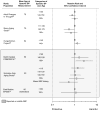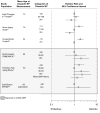The association between blood pressure and incident Alzheimer disease: a systematic review and meta-analysis
- PMID: 21705906
- PMCID: PMC3640480
- DOI: 10.1097/EDE.0b013e31822708b5
The association between blood pressure and incident Alzheimer disease: a systematic review and meta-analysis
Abstract
Background: Many epidemiologic studies have considered the association between blood pressure (BP) and Alzheimer disease, yet the relationship remains poorly understood.
Methods: In parallel with work on the AlzRisk online database (www.alzrisk.org), we conducted a systematic review to identify all epidemiologic studies meeting prespecified criteria reporting on the association between hypertension, systolic BP, or diastolic BP and incident Alzheimer disease. When possible, we computed summary measures using random-effects models and explored potential heterogeneity related to age at BP assessment.
Results: Eighteen studies reporting on 19 populations met the eligibility criteria. We computed summary relative risks (RR(Σ)) for 3 measures of BP: hypertension (RR(Σ) = 0.97 [95% confidence interval = 0.80-1.16]); a 10-mm Hg increase in systolic BP (RR(Σ) = 0.95 [0.91-1.00]); and a 10-mm Hg increase in diastolic BP (RR(Σ) = 0.94 [0.85-1.04]). We were unable to compute summary estimates for the association between categories of systolic or diastolic BP and Alzheimer disease; however, there did not appear to be a consistent pattern across studies. After stratifying on age at BP assessment, we found a suggestion of an inverse association between late-life hypertension and Alzheimer disease and a suggestion of an adverse association between midlife diastolic hypertension and Alzheimer disease.
Conclusions: Based on existing epidemiologic research, we cannot determine whether there is a causal association between BP and Alzheimer disease. Selection bias and reverse causation may account for the suggested inverse association between late-life hypertension on Alzheimer disease, but, given the expected direction of these biases, they are less likely to account for the suggestion that midlife hypertension increases risk. We advocate continuing systematic review; the AlzRisk database entry on this topic (www.alzrisk.org), which was completed in parallel with this work, will be updated as new studies are published.
Figures






Comment in
-
Hypertension and Alzheimer disease: is there a link?Epidemiology. 2012 Jan;23(1):176-7; author reply 177-8. doi: 10.1097/EDE.0b013e31823b679c. Epidemiology. 2012. PMID: 22157315 No abstract available.
References
-
- Stampfer MJ. Cardiovascular disease and Alzheimer’s disease: common links. J Intern Med. 2006;260(3):211–23. - PubMed
-
- Breteler MM. Vascular risk factors for Alzheimer’s disease: an epidemiologic perspective. Neurobiol Aging. 2000;21(2):153–60. - PubMed
-
- Zekry D, Hauw JJ, Gold G. Mixed dementia: epidemiology, diagnosis, and treatment. J Am Geriatr Soc. 2002;50(8):1431–8. - PubMed
-
- Schneider JA, Arvanitakis Z, Bang W, Bennett DA. Mixed brain pathologies account for most dementia cases in community-dwelling older persons. Neurology. 2007;69(24):2197–204. - PubMed
-
- Prins ND, van Dijk EJ, den Heijer T, Vermeer SE, Koudstaal PJ, Oudkerk M, Hofman A, Breteler MM. Cerebral white matter lesions and the risk of dementia. Arch Neurol. 2004;61(10):1531–4. - PubMed
Publication types
MeSH terms
Grants and funding
LinkOut - more resources
Full Text Sources
Other Literature Sources
Medical
Miscellaneous

